A totally biased comparison of Zutty (to some better-known X terminal emulators)
Zutty is the best X terminal emulator you have never heard of. It employs a radically simple, massively parallel rendering algorithm to completely offload the work of drawing the terminal screen to the GPU. This is quite different from how other terminal emulators operate, GPU-accelerated ones included. You can read more on How Zutty works.
Here I am interested in comparing Zutty to some alternatives: partly those that are well-known and have been around for many decades, but also (and especially) to other, newer programs similar to Zutty in that they also employ some kind of GPU-based rendering.
The comparison will be unashamedly biased: as the author of Zutty, I have a natural tendency to select criteria that makes Zutty look good. At the same time, I will try to make a fair comparison based on quantifiable metrics. Please note: I am in no way trying to convey that Zutty is altogether superior to any of the programs mentioned here; all of the programs are useful to at least some people and they have been written by obviously talented and dedicated programmers. I do not believe in reducing ranking among programs to a one-dimensional metric (a.k.a, “which program is better/best”), as the answer is, in nearly all aspects, “it depends”. The standard disclaimer also applies: terminals are notoriously complex beasts and my findings with any of the terminals might be due to “other factors” (including my own mistakes).
That said, I will aim to show that Zutty provides a compelling set of features at a high level of correctness and excellent performance characteristics. Compared to existing GPU-accelerated terminal emulators, Zutty runs on a wider range of graphics hardware by virtue of only requiring OpenGL ES as opposed to “desktop” OpenGL, and its resource demands are otherwise minimal. All this is provided by a relatively tiny codebase.
Zutty has been written from scratch, and while doing so, I have not consulted the implementation of any other terminal emulator. As a result, Zutty has a clean-room codebase unencumbered by historical baggage. The pervasive cross-pollination observed across the terminal emulator ecosystem is not necessarily a problem in itself, but fresh blood certainly makes for better diversity than endless recycling.
At the same time, one could argue that Zutty is not for everyone: it
runs on Linux only [update: plus FreeBSD and OpenBSD], and is tied
to the X client API (if only for creating a window and receiving
events). It has relatively little in the “fancy features” department,
even though it is quite configurable (for the things I care about,
anyway). But it also has a list of missing features: things that
should eventually be supported, but are currently missing.
Comparison criteria will be grouped into three broad categories: Features and correctness; performance and resource usage; and finally miscellaneous (developer-oriented) metrics. For measurements of typing latency, check out my follow-up article.
Programs included in this comparison
All programs are actively developed with publicly accessible codebases and recent releases. Sorted in decreasing order of popularity/ubiquity (no science here, just my gut feeling):
-
xterm: The standard terminal emulator for the X Window System, the venerable xterm is the mother of all X terminal emulators. Carrying several decades of historical baggage, but at the same time complete with support for (almost) any terminal-related standard or feature. Runs on every platform supported by the X Window System.
-
gnome-terminal: The GNOME Terminal Emulator, as its name suggests, is the official terminal emulator provided by the GNOME project. It is released under the GNU GPLv3 or later. Gnome terminal uses the VTE library under the hood, which places it on equal footing with Xfce-terminal, Terminator, and a long list of others. Enormous installed base.
-
urxvt: Also known as rxvt-unicode, a Unicode-oriented reboot of rxvt, itself a dumbed down clone of xterm. Boasts features such as “crash-free”, “flicker-free”, using much less memory than xterm, customizability with embedded Perl, etc. Still widely used and referred to, and has a reputation of being fast. Released under the GNU GPLv3.
-
st: A “simple terminal” provided by the “suckless” project. It is released under the X/MIT license. This program expressly positions itself as minimal (bloat-free) and highly performant. Configuration requires recompilation.
-
Alacritty: The first GPU-accelerated terminal emulator to achieve widespread adoption, famously claiming itself to be “the fastest terminal emulator in existence” (more on this claim below). Written in Rust, a new language for systems programming. Runs on several UNIX-like platforms (including MacOS) as well as Windows. Distributed under the Apache 2.0 license.
-
Kitty: Another GPU-accelerated terminal written in C and Python. Has its own framework for extensions written in Python. Runs on Linux and MacOS. Advertises itself as a “feature full [sic], cross-platform, fast, GPU based” terminal emulator. Released under the GNU GPLv3.
-
Zutty: GPU-accelerated terminal emulator written by this author, aimed at low-end (low-cost, low-energy) systems with hardware support for OpenGL ES 3.1. Written in C++, runs on Linux and other UNIX-like systems (tested on FreeBSD and OpenBSD). Released under the GNU GPLv3.
Test environment
My regular low-energy home desktop system is an ASUS TinkerBoard S with an RK3288 32-bit SoC containing an ARM Mali T760 GPU providing hardware support for OpenGL ES 3.2. Unfortunately, not all tested programs are capable of running on this (otherwise quite capable) system: Alacritty and Kitty require “desktop” OpenGL and thus cannot run on this board. On the other hand, Zutty runs perfectly fine and is my primary terminal here.
For the purposes of this article, my test system is a six year old
Lenovo laptop with a 4-core i5-4210U CPU and an Intel Haswell Mobile
chipset with integrated graphics, providing hardware support for
OpenGL ES 3.1 and OpenGL 3.0. Contrary to my low-energy desktop, this
is a 64-bit system. The software is Debian Buster (current stable); I
use the i3 window manager, and the configured locale is en_US.UTF-8.
All terminal window screenshots linked into this article were produced by the automated testing toolkit of Zutty. As documented, this toolkit is capable of evaluating other terminals as well as Zutty, and to collect the screenshots and data presented below, I relied on exactly this capability.
Features and correctness
The below table summarizes essential features of each tested terminal.
The value of TERM within the shell started by the terminal conveys
the terminal’s type to programs being run in it. For terminals
providing their own terminfo entries, the table links to that data as
well as a diff to the quasi-standard xterm-256color used by others.
Device attributes (VT self-identification) are what the terminal proclaims about itself when queried. This is revealed by VTTEST menu items 6.4 and 6.5, and the links PDA (primary device attributes) and SDA (secondary device attributes) lead to the corresponding screen captures of each program.
| program | tested version | configured font | TERM setting | VT self-id |
|---|---|---|---|---|
| gnome-terminal | 3.30.2, VTE 0.54.2 | Monospace 11 | xterm-256color | VT525: PDA SDA |
| Zutty | 0.6 | misc-fixed 9x18 | xterm-256color | VT520: PDA SDA |
| xterm | 344 | misc-fixed 9x18 | xterm-256color | VT420: PDA SDA |
| Kitty | 0.19.3 | DejaVuSansMono | xterm-kitty [diff] | VT220: PDA SDA |
| Alacritty | 0.4.3 | DejaVuSansMono | xterm-256color | VT102: PDA SDA |
| st | 0.8.2 | Default OOTB | st-256color [diff] | VT102: PDA SDA |
| urxvt | v9.22 | misc-fixed 9x18 | rxvt-unicode-256color [diff] | VT102: PDA SDA |
All established programs were tested with their version present in Debian Buster (current stable). The latest stable release of Kitty was manually installed, as was Alacritty. Alas, Alacritty stopped releasing .deb files, so I tested their last version for which a .deb was released.
VT support levels
The above table is sorted by descending level of proclaimed terminal
support. The difference between implementing a VT400 or VT500 terminal
(provided the implementations are correct) is relatively
inconsequential. The same cannot be said of the gap between these and
VT220-level terminals. Programs running in a less capable virtual
terminal must sometimes use longer series of basic escape sequences to
achieve the results of a fewer number of more modern ones. For
example, the DECLRMM control sequence (set left-right margin mode) is
available from the VT420 and up, and will be used to restrict
scrolling to the active part of two horizontally split tmux panes. On
less capable terminals, tmux is forced to perform more work to
achieve the same result. This is quite similar to how extended
instructions on modern CPUs allow machine code to be more efficient
than code compiled for an older machine. In other words, not
implementing a modern VT variant goes directly counter to greater
efficiency. And there is yet another downgrade from VT220 to those
terminals that only claim to support VT100/VT102.
It is surprising how unambitious the newer terminals Alacritty and Kitty are in this regard. I would have hoped that new, supposedly state-of-the-art entrants would take the effort to add support for modern VT standards. Switching from xterm to Alacritty (or any other modern terminal) should not be a major downgrade.
Side note on VT52 support
On the low end of the VT level hierarchy sits the VT52. This is purely of academic interest in 2020, but still: there is technically no way for a “VT100 or better” terminal to be standards-compliant and not support VT52 (as the VT100 spec contains a sequence for downgrading into VT52 mode). Also, given that VT52 is a (small) subset of what the VT100 is capable of, any reasonably well structured implementation should find it easy to fit this in with a minimal amount of additional code. However, of all the terminals included in this test, only xterm, urxvt and Zutty implement VT52 mode.
TERM settings
Another problem area for newer entrants into the terminal ecosystem is
the value of TERM set in the shell. This is a bit of a catch-22 for
all programs that are not xterm, since they can choose from two less
than great options. One, they can provide a terminfo entry that
accurately describes their capabilities, and require that users
install these (often separately packaged) files to be able to
correctly use the terminal. This sounds fine, unless you realize that
the terminfo is required on all remote systems as well that you
would ever want to SSH into, in order for your local terminal emulator
to work as intended. The second option is to “hijack” the terminfo of
a well-known, modern terminal, which in practice is almost always
xterm-256color (or more generally, xterm-*). Now, the problem
becomes that your terminal is not xterm, but since the client
application has no way of knowing this, any incompatibilities will
cause breakage.
Notably, Kitty has gone down the route of providing its own terminfo
xterm-kitty (the naming in itself has become a
source
of
controversy),
and has its obligatory FAQ entry for the “unknown terminal” kind of
error – clearly not the ideal path to user satisfaction. On the other
hand, Alacritty simply declares itself as just another xterm – while
supporting only VT102. This is actually less problematic than it
looks: applications should query the terminal’s support level (device
attributes) instead of jumping to conclusions based on its name. For
Zutty, I have chosen the second path, as Alacritty and countless
others before me, with the significant difference of aiming for modern
VT support.
Support for bitmap fonts
Neither Alacritty nor Kitty seems to support bitmap fonts. This is sad, because in my humble opinion, some of the old-school bitmap fonts are still the best option for putting crisp, well-readable text on low-resolution computer displays (between 70 and 120 dpi). I have a strong personal preference towards working with the misc-fixed 9x18 font (which provides excellent Unicode support), and there is no way to use this font (or any other such font) on these terminals. Again, switching from xterm to Alacritty (or any other modern terminal) should not be a downgrade. With Zutty, I also hope to make a statement of keeping bitmap fonts usable in modern terminals.
Correctness of claimed VT support
The sadness only deepens when one starts to scrutinize the actual conformance levels of the terminals against well established standards and prior art set by the actual VT-series terminals manufactured by DEC, independent standards such as ISO-6429 (ECMA-48), as well as established programs such as xterm. Here we defer to the VTTEST program as the source of truth.
Sadly, this section is going to look like an endless list of bugs. I have to state up-front that different programs have different development goals, and achieving a perfect score on VTTEST is probably not the most important goal for most of them (or the below sections would look very different).
My personal view is that correctness is important – if you claim yourself a VT100 (or better), you better act like one. Not everyone agrees with me though: if presented with a choice, some people will prefer transparent backgrounds instead (and some of them will go on and write their own terminals). To be clear: there is nothing wrong with this, as long as everyone is allowed to choose the programs they use, or decide to write their own.
All screens will be presented side by side with the output of Zutty for comparison, but feel free to play along with xterm instead (you will see identical results).
gnome-terminal
Given that gnome-terminal identifies itself as a VT525 and sets TERM
to xterm-256color, and given its ubiquity (being the default
terminal of the GNOME Desktop), expectations on its compatibility are
set high. But alas:
| gnome-terminal | Zutty |
|---|---|
2.2. TAB setting/resetting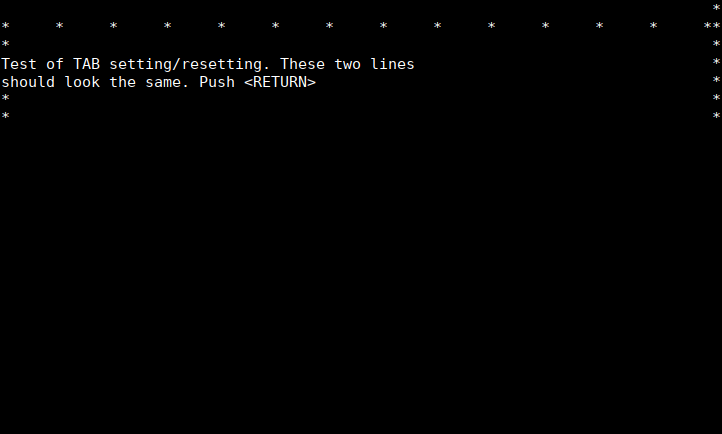

| |
6.2. LineFeed/NewLine mode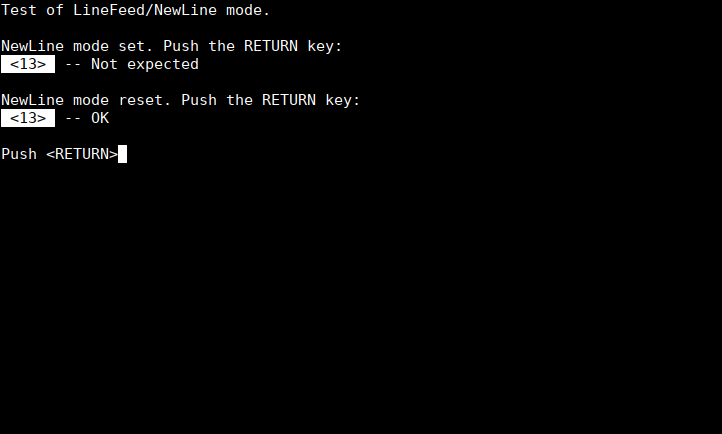

| |
11.3.2.9. Cursor movement within margins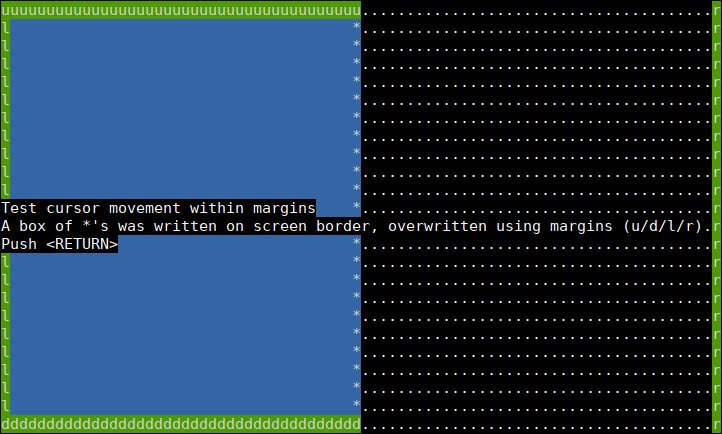

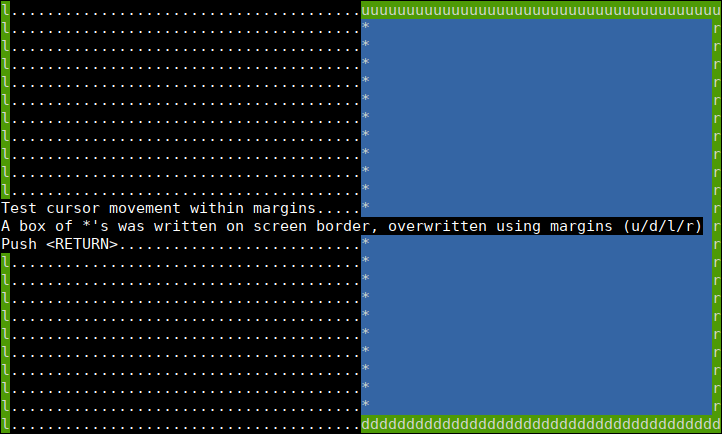

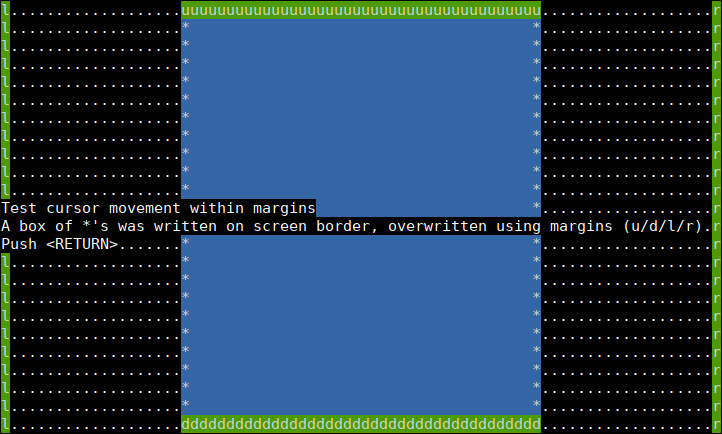

| |
11.3.2.10. Other movement within margins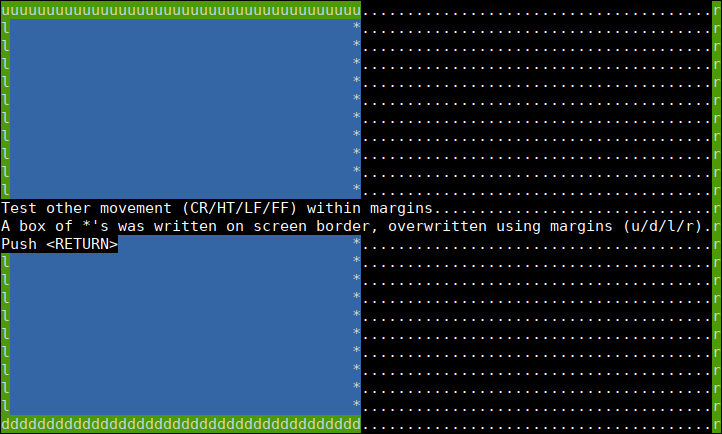

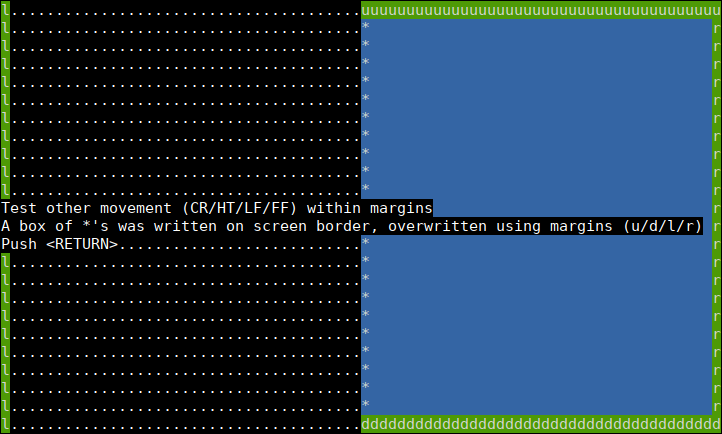

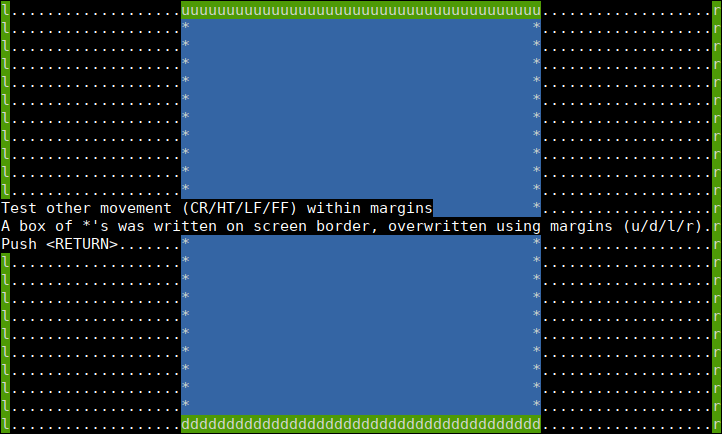

| |
11.3.3.9. Insert/delete column (DECIC/DECDC)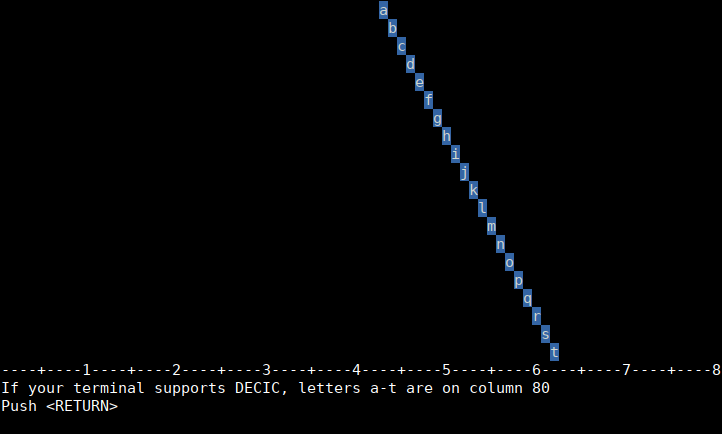

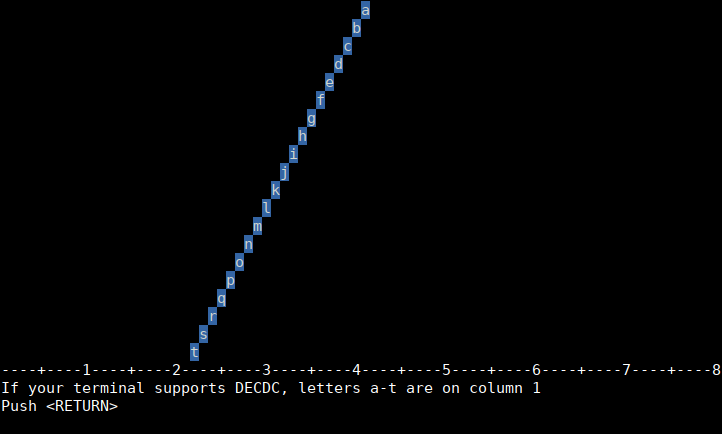

| |
11.3.3.11. Insert/delete line (IL, DL)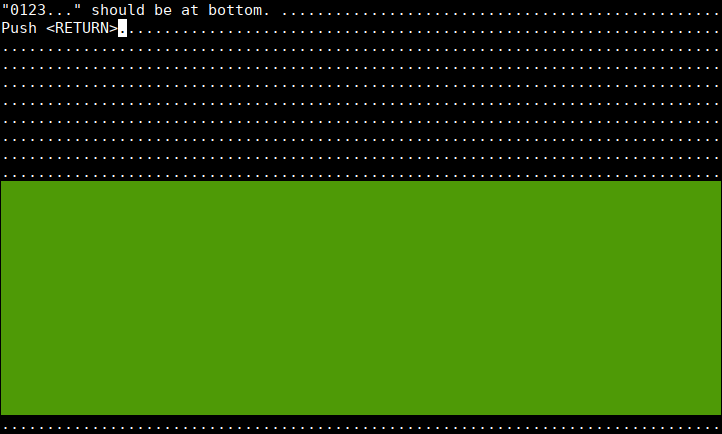

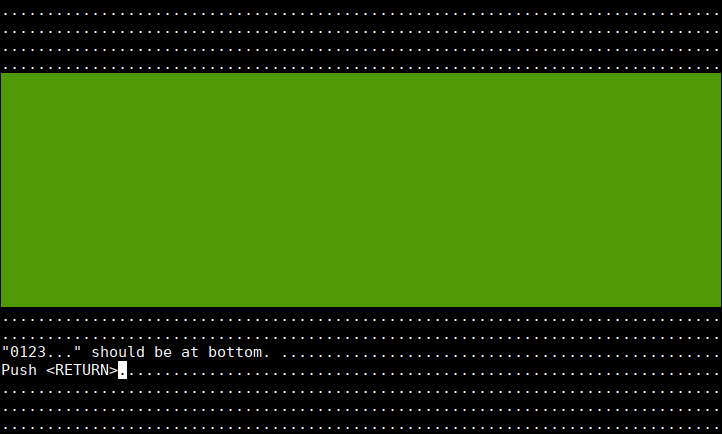

| |
11.3.3.13 ASCII formatting (BS, CR, TAB)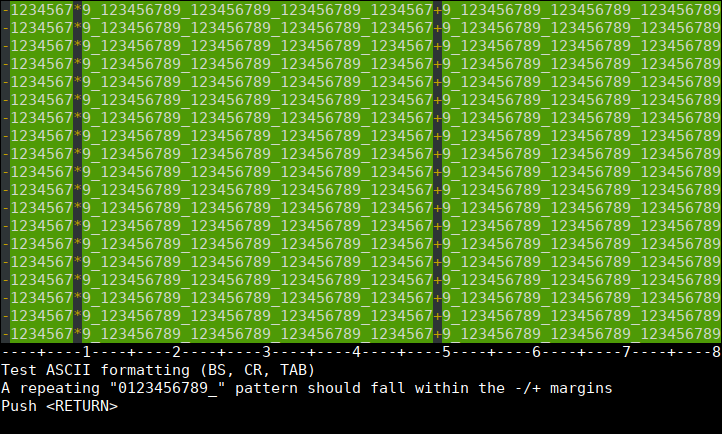

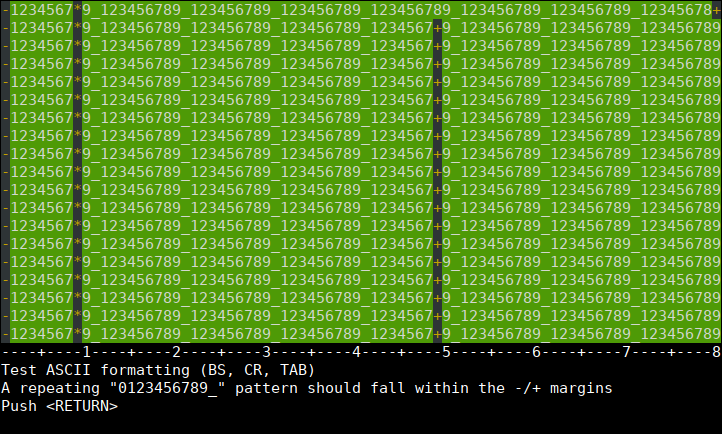

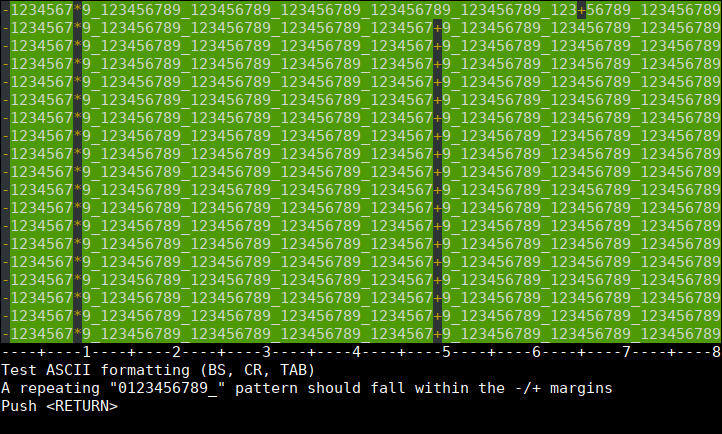

| |
11.3.4. Backarrow key (DECBKM)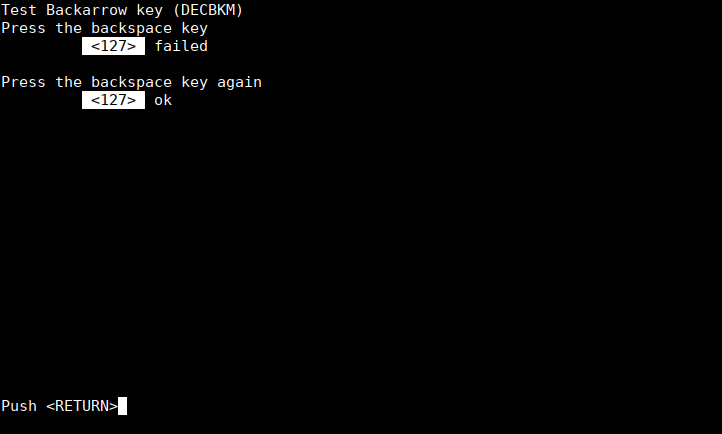

| |
11.4.2.10. Cursor-Horizontal-Index (CHR)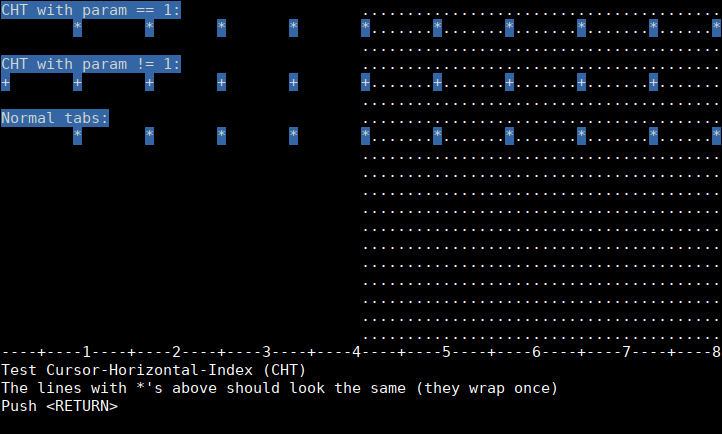

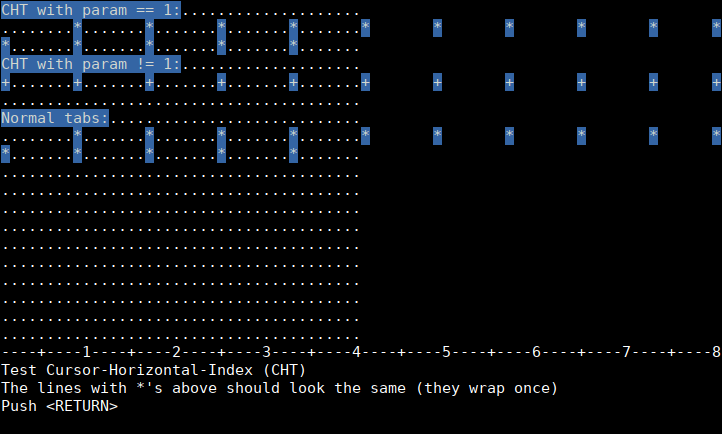

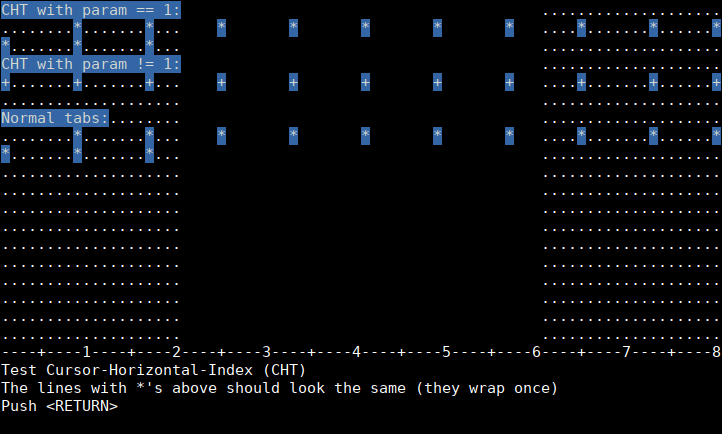

| |
11.4.2.11. Horizontal-Position-Relative (HPR)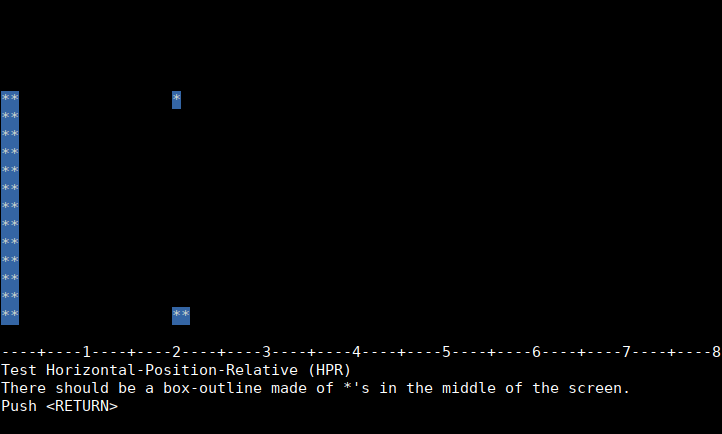

| |
11.4.2.15. Vertical-Position-Relative (VPR)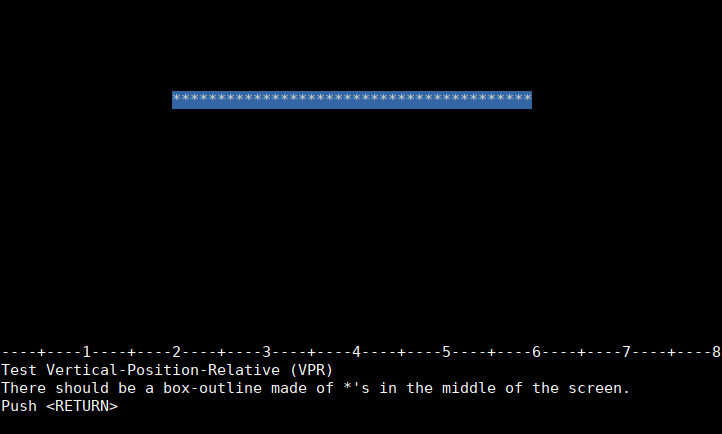

| |
11.6.3. SGR-0 color reset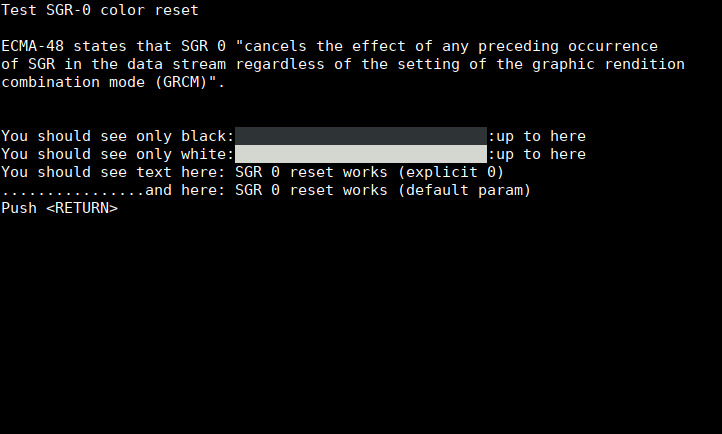

| |
11.7. Scroll-Left (SL), Scroll-Right (SR)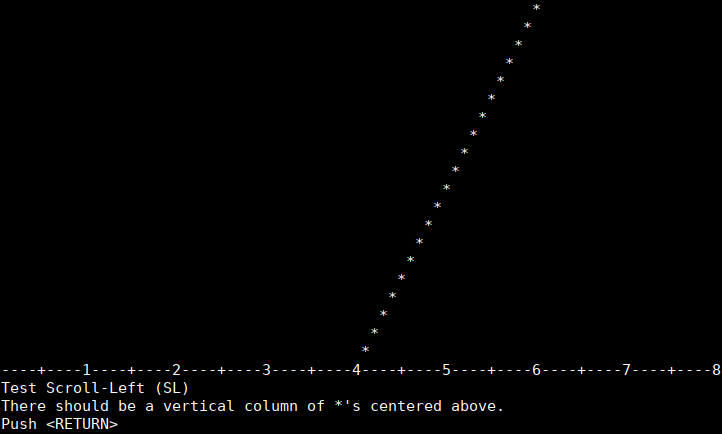

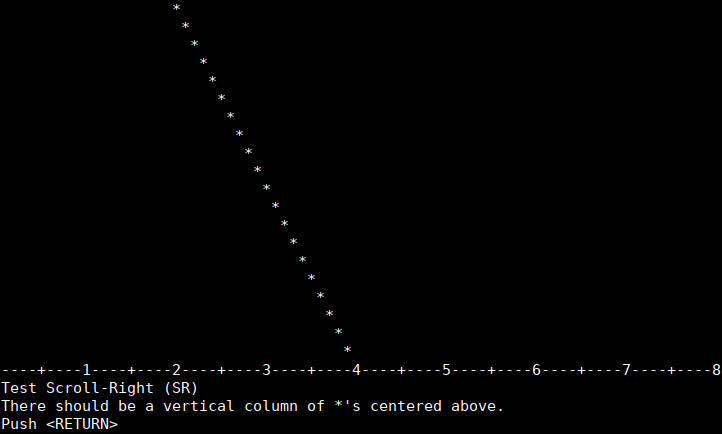

| |
Surprise: a steaming pile of bugs in various problem areas, some of them pretty basic (such as TAB handling). Horizontal margins (VT420 and above) seem to be completely unsupported, as well as various other sequences from VT420, VT520 and ISO-6429 (ECMA-48) – not entirely sure if the latter is in scope. Overall, a puzzling outcome!
Digging a bit further, I discovered some ambiguity on whether
gnome-terminal supports the claimed VT520 level at all: its
manpage
(not organic to the project, but contributed by Debian) has this to
say about the support level of gnome-terminal: Run any application
that is designed to run on VT102, VT220, and xterm terminals.
That is pretty sloppy as far as specifications go. Apparently, it might be the case that nothing above VT220 is intentionally supported by gnome-terminal at all, and that its primary device attributes response is a big fat lie. Note: the xterm FAQ entry about known bugs also has a section about gnome-terminal.
As a closing note on this program: I did discover the existence of the
gnome-256color terminfo. In absence of any clear documentation, I am
guessing that this might be intended as a closer match to the
terminal’s capabilities than the default xterm-256color. However,
the latter is the default value of TERM within gnome-terminal, and in
fact I have not found any way to persuade the program to change this.
Nevertheless, I verified that manually changing TERM to
gnome-256color does not affect the issues outlined above in any
way.
Okay, let’s move on to some more modern, GPU-accelerated terminals!
Kitty
According to the author of Kitty, tmux is a bad idea, apparently because it does not care about the arbitrary xterm-protocol extensions Kitty implements. Ostensibly, terminal multiplexing (providing persistence, sharing of sessions over several clients and windows, abstraction over underlying terminals and so on) are either unwarranted and seen as meddling by a middleman, or should be provided by the terminal emulator itself (Kitty being touted as the innovator here). A remarkable standpoint, to say the least.
Kitty comes with its own terminfo xterm-kitty. This needs separate
manual installation (I don’t run curl-pipe-shell installers – this
newfangled fashion is spreading like a disease, but it is a
Very
Bad
Idea
Nevertheless).
Apart from minor
differences (consult
terminfo(5)
if you are interested in decoding them), the main point of difference
is that Kitty does not support background colour erase (cap-name
bce), in favour of its proposed (self-implemented) extensions,
promoting capabilities such as support for coloured, wavy underlines
and drawing arbitrary raster images in the terminal.
Nevertheless, the basic VT implementation has some potholes to fix:
| Kitty | Zutty |
|---|---|
1.3. Autowrap, mixing control and print characters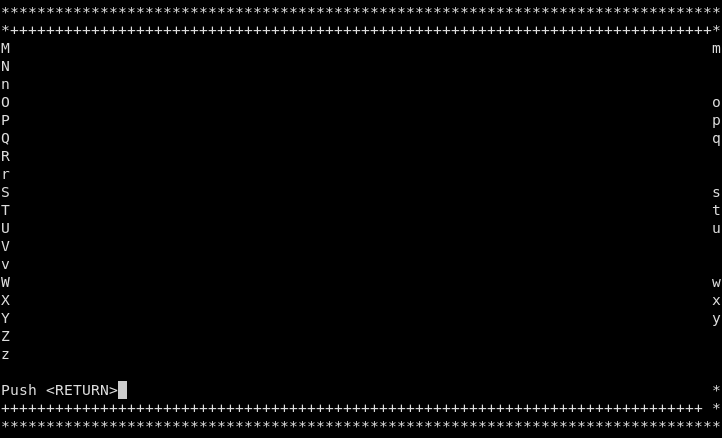

This screen tests the faithful reproduction of quirky original VT behaviour; read about it in the section Glitches and Braindamage of the terminfo(5) manual page, or see wraptest, a testing tool dedicated to this issue. The xterm FAQ has its own entry about it, as well as a screenshot gallery of various terminals, compliant or not. Fun fact: the xterm-kitty terminfo includes xenl a.k.a. the "eat-newline-glitch" capability,
just like all other terminals with VT100 in their ancestry...
| |
6.2. LineFeed/NewLine mode

This should be implemented by anyone claiming to be a VT100 or better. | |
6.3. Device Status Report (DSR)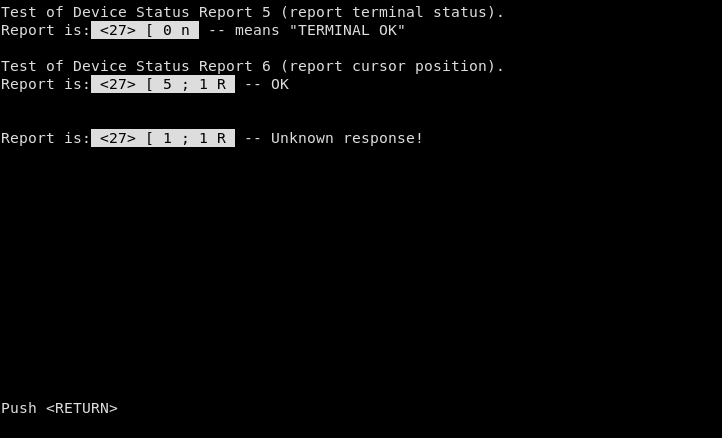

Like the previous screen, this is in scope for a VT100 or better. The problem here is with the response to the last query, which is when VTTEST asks for a cursor position report after enabling DECOM (origin mode). | |
11.1.2.1. Send/Receive mode (SRM)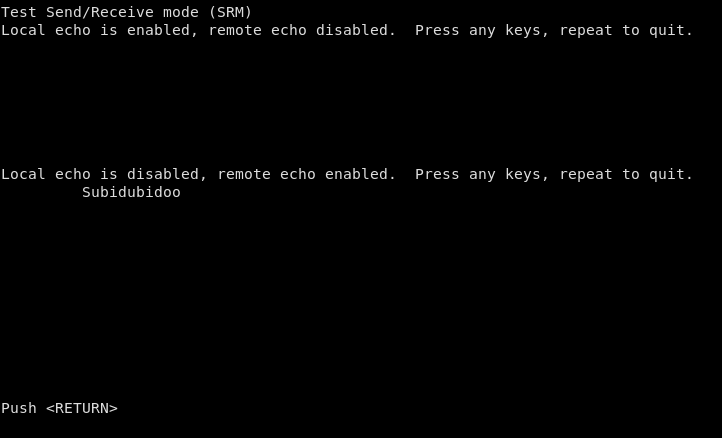

Local echo seems not to be supported, even though it is totally in scope for a VT220. | |
At this point I stop the VTTEST tour of Kitty, simply because it would be deeply unfair to test a VT220 for things it does not even claim to support (spoiler alert: it is a mixed bag – some work, others do not). But see the above section titled “VT support levels” on why, in my opinion, a modern terminal should consistently support modern VT levels.
Alacritty
Alacritty certainly has a set of interesting design choices, partially overlapping those of Zutty when it comes to sticking with the basics and providing excellent performance. Alas, Alacritty only claims to be a VT102 (a downgrade even from Kitty’s perspective); I guess that is part of the simplicity thing going on. At least that makes its test surface much smaller, so let’s see how well those basics are covered:
| Alacritty | Zutty |
|---|---|
6.2. LineFeed/NewLine mode

VT100 and up should clearly support this. | |
6.3. Device Status Report (DSR)

Ditto here: this is in scope for VT100 and above. The problem is the same as with Kitty, although the response is different, recognized by VTTEST as the response that would be correct, had it not enabled DECOM (origin mode) prior to this query. | |
11.8.7. XTERM Alternate-Screen features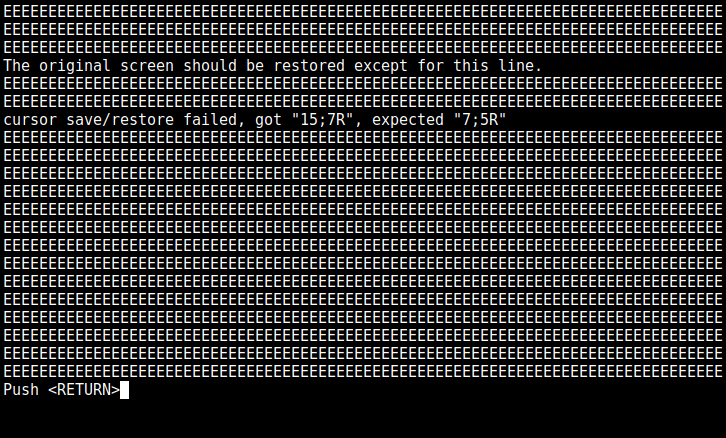

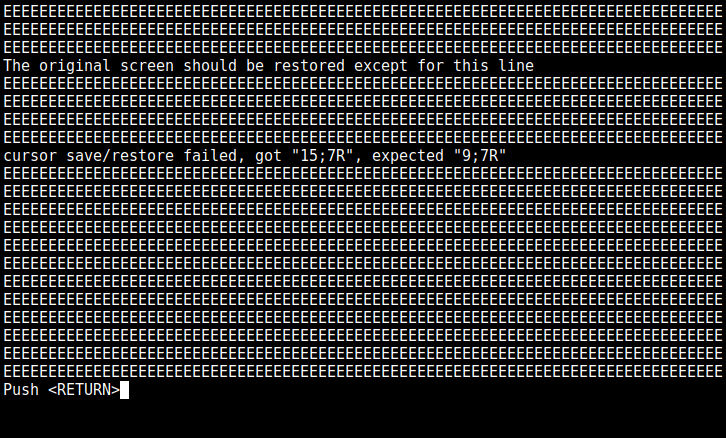

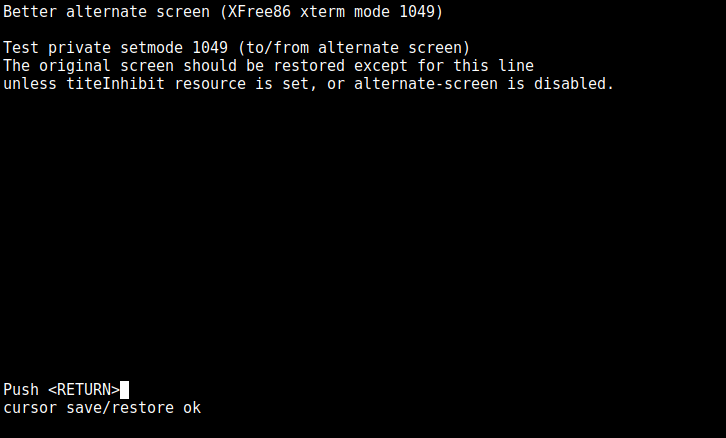

A sigh of relief: Alacritty implements at least one of the three sequences for alternate-screen save-restore. Technically, these sequences are xterm extensions, but in practice everybody has supported them since forever. The sequence supported by Alacritty is the latest and arguably the best, obsoleting older ones. One could argue that those are not needed; however, any reasonably structured program will only need to expend minimal code to keep supporting the older methods (as most other programs do). | |
In conclusion: some missing features here and there – not great, not terrible. Definitely not great, considering how small the promised feature set of a VT102 is compared to a VT520. At least basic screen output rendering is correct.
st (simpleterm)
The “simple terminal” from suckless boasts minimalism as its primary strength. As such, it is similar to Alacritty (albeit much older) and also does not seek to go beyond VT102 support.
| st | Zutty |
|---|---|
1.3. Autowrap, mixing control and print characters

According to the st homepage, "xterm is bloated and unmaintainable" (hmm, to me it looks like xterm has been maintained just fine, for decades). On the other hand, st is evidently so minimal that it does not even include correct (basic) VT behaviour. In this case, the suspect is not the xenl quirk (present in the st-256color terminfo
as expected), rather it looks like st does not correctly support
DECSTBM (set top/bottom margins) and/or DECOM (origin mode). Maybe st
has pursued minimalism to a fault?
Note: the maintainer of xterm has published a screenshot of st-0.4 exhibiting this issue. I have tested st-0.8.2; fixing this was clearly not a priority. [Additional notes and links on the issue under this same screen for Kitty.] | |
2.15. Save/Restore Cursor (plus attributes)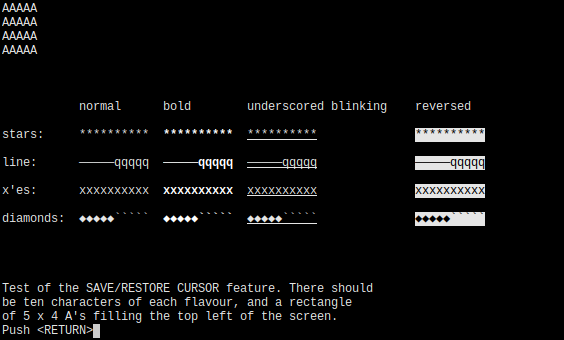

Minimalism also appears to exclude correctly saving and restoring attributes along with cursor save/restore operations. | |
6.3. Device Status Report (DSR)

At this point, I am all but surprised: st is minimal indeed. | |
On the plus side, st does support LineFeed/NewLine mode, as well as Send/Receive mode (SRM) a.k.a. local echo on/off. And, despite all the focus on minimalism, all three alternate-screen save/restore sequences are supported and working correctly (looking at you, Alacritty)!
urxvt
| urxvt | Zutty |
|---|---|
1.3. Autowrap, mixing control and print characters

This xterm FAQ entry mentions rxvt as one of the terminals known to be inconsistent with standard VT100 behaviour; the corresponding screenshot notes "Old and new versions of rxvt behave the same; its divergence from VT100 is old and well-established." Apparently, this extends to urxvt as well. (In case you were wondering: the rxvt-unicode-256color terminfo includes xenl.)
| |
6.3. Device Status Report (DSR)

The same as Alacritty and st, arguably "less wrong" than Kitty. | |
On the bright side, LineFeed/NewLine mode is present. Send/Receive mode (SRM) is not, but that is out of scope for a VT102. Cursor show/hide is out of scope as well, but that works. In fact, quite a lot of higher level stuff is implemented, such as (VT420) backward/forward index (DECBI, DECFI), vertical scrolling (IND, RI), insert/delete line (IL, DL), insert/delete char (ICH, DCT), even the backarrow key (DECBKM) – plus (VT520) HPA, CHA, CBT, and so on. As a bonus, all three alternate-screen save/restore sequences are supported (khrrm Alacritty). All in all, not too bad for a VT102.
xterm and Zutty
So what about xterm and Zutty? You might be asking why they are not getting their own sections here. For xterm, suffice it to say that it is maintained by Thomas E. Dickey, who also maintains ncurses and VTTEST. Also note that xterm is (by a large margin) the oldest of all the programs listed here, and a de-facto standard. Thomas has once counted the control sequences supported by various terminals; xterm provides the most comprehensive support (by a wide margin). Thomas is widely acclaimed for his ongoing, meticulous work on maintaining the programs mentioned above (and more); there is really not that much room for error here.
And regarding Zutty: I used it to provide the reference images for all the above highlighted issues, obviously to make a statement. Zutty has been carefully written to match the output of xterm as much as possible – for a great number of rendering tests, it is verified to produce pixel-identical output if set up with the same font. Almost all deviations from xterm are due to “not yet implemented” features, documented in their own list (see the bottom of the README).
Feel free to consult the VTTEST results of Zutty for the complete list of screens covered by the testing toolkit of Zutty. There are a lot more screens in VTTEST, but I believe I have covered the most interesting ones.
UTF-8 handling
All programs claim to be Unicode or UTF-8 terminals, and a good implementation should handle error cases just as well as decoding correct UTF-8 data. A comprehensive test of the corner cases is presented by Markus Kuhn’s UTF-8 decoder capability and stress test.
The Zutty automated testing toolkit has a suite for displaying snippets from this file and verifying the results. The primary aim of this is to detect regressions in Zutty. The results of what other programs produce is included in the table below (you will have to click on the links to see the screen captures).
Disclaimer: As Markus writes in his first paragraph, “This file is not meant to be a conformance test. It does not prescribe any particular outcome. Therefore, there is no way to “pass” or “fail” this test file, even though the text does suggest a preferable decoder behaviour at some places.” Which is exactly what we do here, comparing implementations on how close they are to the preferable decoder behaviour. That is, deviations are not necessarily bugs in any program, merely implementation choices that differ from the preferable ones. Please refer to the linked document to understand why results shown as DVN (for “deviation”) are less than preferable.
| program | 01 | 02 | 03 | 04 | 05 | 06 | 07 | 08 | 09 | 10 | score |
|---|---|---|---|---|---|---|---|---|---|---|---|
| Zutty | good | good | good | good | good | good | good | good | good | good | 10 |
| xterm | DVN | DVN | good | good | DVN | good | good | DVN | good | DVN | 5 |
| st | DVN | DVN | good | good | DVN | good | DVN | DVN | good | DVN | 4 |
| gnome-terminal | DVN | DVN | good | DVN | DVN | good | DVN | DVN | DVN | DVN | 2 |
| alacritty | DVN | DVN | DVN | DVN | DVN | DVN | DVN | DVN | good | DVN | 1 |
| kitty | DVN | DVN | DVN | DVN | DVN | DVN | DVN | DVN | DVN | DVN | 0 |
| urxvt | DVN | DVN | DVN | DVN | DVN | DVN | DVN | DVN | DVN | DVN | 0 |
Performance and Resource usage
Once again, the testing toolkit of Zutty serves as the foundation of our measurements reported here.
To level the playing field, scrollback has been disabled in all terminals:
- xterm: the
-sl 0option was used - gnome-terminal: the option “Limit scrollback” was enabled with a setting of 0 lines
- urxvt:
URxvt.saveLines: 0was added to~/.Xresources(and the xrdb reloaded) - Alacritty: the
scrolling.historyconfiguration value was set to 0 - Kitty: the
scrollback_linesconfiguration value was set to 0
All programs were manually verified to ensure that the changes have taken effect. Since st and Zutty do not (currently) support scrollback, no adjustments to them were necessary. [Update: Zutty has since gained support for scrollback.]
The dumb terminal test
This is arguably the dumbest possible performance test of any text terminal, and consists of outputting a very long (3.4 MB) text file containing (mostly) very short lines with English words, one per line. This will be repeated 100 times and the overall timing and data throughput will be computed at the end. Since the input does not contain any terminal controls (escape sequences), it is a measure of the raw incoming data rate the terminal can sustain while frequently forced to scroll/page its output. This load resembles one extreme end of the way a terminal can be used.
Reported metrics in the below table are as follows:
- real, user, sys: overall timing statistics as reported by time(1). Numbers are in seconds.
- RSS: resident set size, a.k.a. in-memory (non-swapped) physical memory allocation, measured at the end of the test (just before the program under test exits) via ps(1). Numbers are in kB.
- MAJFLT, MINFLT: count of major and minor page faults, acquired in the same measurement as RSS.
- PTY read: calculated read rate, in MB/s, indicating the average speed of consuming the input file.
Sorted by increasing overall timings (fastest program first):
| program | real | user | sys | RSS | MAJFLT | MINFLT | PTY read rate |
|---|---|---|---|---|---|---|---|
| Alacritty | 16.24 | 0.05 | 16.16 | 30,656 | 1 | 2,930 | 21.75 |
| urxvt | 18.46 | 0.06 | 18.35 | 16,104 | 0 | 2,430 | 19.14 |
| Zutty | 24.65 | 0.04 | 24.55 | 23,912 | 0 | 3,748 | 14.33 |
| gnome-terminal | 36.19 | 0.03 | 18.55 | 41,624 | 0 | 4,894 | 9.76 |
| Kitty | 45.91 | 0.07 | 23.69 | 52,736 | 0 | 11,574 | 7.69 |
| st | 46.08 | 0.03 | 45.18 | 9,432 | 0 | 767 | 7.67 |
| xterm | 912.54 | 0.11 | 103.58 | 10,228 | 0 | 1,589 | 0.39 |
The control sequence-heavy test
This test generates load resembling the other extreme end of possible
terminal usage, by outputting the stream of data written to the
terminal in the course of a complete VTTEST run (refer to vttest.sh
in the Zutty testing toolkit). However, instead of verifying the
correctness of the generated screen output, here we are interested in
the performance of processing the input stream heavy on all kinds of
escape sequences. Screen updates are dominated by intra-screen
rewrites and relatively little scrolling/paging activity is forced.
Similar to the previous test, the input is fed into the terminal
several times in a row (400 times for this test), and overall timing
and throughput for the whole run is measured and calculated.
Results in the same format as above:
| program | real | user | sys | RSS | MAJFLT | MINFLT | PTY read rate |
|---|---|---|---|---|---|---|---|
| Zutty | 8.59 | 2.18 | 5.73 | 24,004 | 1 | 3,750 | 45.09 |
| Alacritty | 11.61 | 2.07 | 5.77 | 28,520 | 48 | 3,001 | 33.36 |
| Kitty | 21.20 | 2.10 | 5.94 | 56,744 | 81 | 10,362 | 18.27 |
| st | 22.82 | 2.19 | 6.61 | 9,780 | 0 | 981 | 16.97 |
| gnome-terminal | 25.93 | 2.03 | 5.15 | 41,436 | 0 | 5,394 | 14.94 |
| urxvt | 37.07 | 2.45 | 7.07 | 21,584 | 2 | 195,393 | 10.45 |
| xterm | 770.76 | 3.76 | 14.63 | 99,800 | 0 | 31,396,048 | 0.50 |
On performance
-
Alacritty scores first in the “dumb terminal” test, about 10% faster compared to urxvt, and 50% faster compared to Zutty. In the second, more demanding test, Zutty is the fastest (50% faster compared to Alacritty). Alacritty is still well ahead (in fact, about twice as fast) as the rest of the pack (Kitty, st and gnome-terminal).
-
Kitty appears to be a mediocre performer, stuck in the middle together with st and gnome-terminal. Kitty is consistently, and by a wide margin, the slowest among GPU-accelerated terminals.
-
Rumors of xterm being slow are not unfounded. Apart from disabling scrollback, I also used the
-joption when running xterm to enable “jump scrolling”. According to the xterm manual, this setting “allows xterm to move multiple lines at a time so that it does not fall as far behind. Its use is strongly recommended since it makes xterm much faster when scanning through large amounts of text”. Apparently, it does not help much – xterm is (very) slow, at least compared to the others: in both tests, about 20x slower than the second slowest. (There is also thefastScrolloption that works by “suppressing screen refreshes for the special case when output to the screen has completely shifted the contents off-screen”. I tried enabling it; xterm ceased to update the screen on the dumb test and its timing results did not improve on the second test.) -
Comparing absolute PTY read speeds across the tests, only urxvt has gotten slower on the second test. Even xterm has managed to improve its (low) speed; all the others have achieved higher read speeds on the second test.
A subjective observation on gnome-terminal: While running the tests, I noticed that this program behaved visibly different than all others, in that its window refresh rate seemed suspiciously low. Instead of the constant high-speed flicker that all others exhibited, gnome-terminal repainted its window with a leisurely rate, which I estimated to be about 10 per second. That is a slide-show relative to the action movie played by the others! I have no explanation for this, but it is very apparent on visual inspection.
As a final note on performance: high throughput is nice, but not especially relevant for interactive use. Round-trip latency (from keypress, through processing, to screen update) is arguably more important, as it determines the (subjective) level of responsiveness. I have a separate article on the typing latency of these programs.
On memory usage
-
Of the three GPU-accelerated terminals, Zutty consistently uses the least amount of memory – less than half of what Kitty consumes, in both tests.
-
Overall, only xterm, urxvt and st are able to consume less memory than Zutty. In the second, more demanding test, only st remains stable and well under Zutty: urxvt is still below, but its resource use has apparently ballooned and its behaviour seems to be less stable.
-
Compared to the “dumb test”, the second test provokes Alacritty, Kitty, urxvt, as well as xterm to trigger many more page faults (a sign of memory allocations). st and gnome-terminal look more stable in this regard, with only slightly increased page fault counts. Zutty is practically unmoved by the difference in workload.
Alacritty vs Zutty
It is readily apparent that Alacritty and Zutty are the two consistently high-performing terminals; nothing else comes even close. Alacritty has a higher variance in its (overall higher) memory usage. Further, it seems that simpler workloads (less control sequences) will favour Alacritty, while Zutty will be faster with more complex workloads. Practically, both terminals are blazing fast, and the difference between them is of no practical importance. (The same cannot be said of their levels of VT support: VT102 and VT520 are very different targets. And let’s not even compare their latency.)
As a trivial real-world test, I ran Alacritty and Zutty side-by-side,
in identically sized windows, started at the same time with identical
display settings (DejaVuSans Mono is the default font for Alacritty,
so I configured Zutty to use the same font). Two instances of the same
htop program, started at the same time, are running side-by-side,
periodically refreshing themselves at the same rate, producing output
based on the same system information. While the exact content of the
two windows is not strictly identical, it is safe to say that the two
terminals are tasked with virtually identical workloads.

Zutty (left) vs Alacritty (right): a side-by-side comparison (click to enlarge)
After a good couple minutes, I captured the above screenshot. It shows that Alacritty consumed 27.12 seconds of CPU time, while Zutty used only 7.93 seconds: a difference of well over 3x in favour of Zutty.
Still, I would be hesitant to declare Zutty “the fastest terminal emulator in existence”. It might be more than three times faster than Alacritty on this particular test, on my particular machine. But terminals are diverse, the computing stack they sit on top of is even more complex, and performance measurements are notoriously tricky.
Miscellaneous: Source code volume
There is widespread agreement on that ceteris paribus, less code is better.
To count source code lines, cloc is used. Only the main implementation languages for each program are left in the table below (summed up into a single row per program), everything else is discarded from the cloc output.
All source repositories were counted at the time of writing this
article (December 2020), taking into account the latest commit on
branch master.
In all fairness, at least some of the code volume counted for the larger programs is probably test code plus maybe even generated code, and I have made no effort to separate those parts from the implementation itself. Still, cloc was run on a fresh clone of each program, only counting files under version control.
Sorted by total LOC numbers:
| program | language | files | blank | comment | code | total | source |
|---|---|---|---|---|---|---|---|
| st | C | 6 | 592 | 430 | 4,333 | 5,355 | link |
| Zutty | C++ | 25 | 768 | 429 | 4,808 | 6,005 | link |
| gnome-terminal | C | 61 | 3,938 | 2,748 | 16,198 | 22,884 | link |
| Alacritty | Rust | 65 | 3,784 | 2,601 | 18,026 | 24,411 | link |
| urxvt | C++ | 107 | 5,840 | 4,039 | 63,183 | 73,062 | link |
| xterm | C | 66 | 8,449 | 11,935 | 81,300 | 101,684 | link |
| Kitty | C, Python | 280 | 12,224 | 12,591 | 179,087 | 203,902 | link |
The only other terminal on the order of Zutty’s source code volume (beating it by about 10%) is st. However, st is a far cry from Zutty on all other accounts: it is only a VT102, comes with some obvious correctness issues, and performance is comparatively worse.
Zutty is about 4x smaller than anything comparable in terms of VT implementation scope (gnome-terminal) or performance (Alacritty); it beats the former on performance and the latter on scope, and both of them on correctness.
All of this only serves to demonstrate the power that lies in the simplicity of How Zutty works.
Conclusion
Is Zutty the best, or fastest, or most [insert favourite adjective] terminal in existence? Yes, or no, or maybe, or (most likely) “it depends”. I am not making any such claims, and I don’t care too much about such badges of honor. There are many other differentiating aspects and features of all the programs mentioned above; I have barely scratched the surface here. As stated before, all terminals are useful in some circumstances, and you should feel free to keep using the one you already have, like, and trust. Or maybe give Zutty a try, in case you have now gotten curious about it.
[Update: since the publication of this, I also wrote a follow-up article on the typing latency of Zutty].